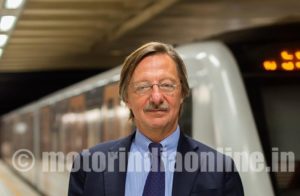MOTORINDIA’s exclusive interview with Alain Flausch, Secretary-General, UITP
UITP is a leading worldwide network functioning with the aim of bringing together all public transport stakeholders and sustainable transport modes. The organization is internationally recognised for its work in advancing the development of critical policy agenda in different countries around the world.
We had an exclusive interaction with Mr. Alain Flausch, UITP General Secretary to find out how UITP keeps pace with the dynamics of global economies.

Excerpts:
The global business environment remains challenging, with a still patchy economic picture, geo-political issues creating uncertainty for business and fierce competition for the road transport sector. Your expert views, please.
The public transport sector helps promote job creation and urban economic growth. As per the UITP Mobility in Cities Study 2015, it is observed that cities with good transport systems are more competitive compared to those with weaker transport systems. Further, it is observed that investment in the public transport sector has its multiplier effect and can create wealth for cities, generating value that exceeds the initial investment up to three or four times.
The Chinese Government, for example, is investing hugely in infrastructure, including public transport, to stimulate economic growth. There is need for more investment in the public transport infrastructure to create healthier and more liveable cities.
As the world moves faster and economies get inter-connected at the global level, technology plays a major role in the automotive sector. Could you provide a broad outline of UITP’s role in the emerging scenario?
Technology plays a very important role in the modern world. The transport sector is witnessing greater technological innovation. UITP recently published a Policy Brief on the new emerging technology innovations in the transport sector. Despite the emergence of ‘new mobility players,’ it is important to remember that the backbone of every mobility strategy remains an efficient public transport system. Public transport has the broadest customer base, and as a sustainable public service it should be the natural integrator of all these services.
Autonomous vehicle and on-demand services should be integrated with the existing or future public transport infrastructure. These new mobility solutions are not going to cover the main part of the citizen’s trips, but they provide the key to less car ownership and in aggregate less car use. Whilst shared modes are excellent in complementing public transport and providing a door-to-door offer, they cannot provide a substitute form of transport for the bulk of mobility requirements.
As many countries are keen on raising the vehicle emission standards, more stringent norms are sure to be incorporated in vehicle technology. What is UITP’s role in emission standards maintenance?
UITP is part of the UN Secretary-General’s High Level Advisory Group on Sustainable Transport, which seeks to promote the integration of sustainable transport in relevant inter-governmental processes, including making recommendations on the formulation and implementation of the post-2015 development agenda.
UITP is also involved with projects such as the European Bus System of the Future 2 (EBSF_2). The project involves demonstrations in real service in 12 cities (Barcelona, Dresden, Gothenburg, Helsinki, London, Lyon, Madrid, Paris Area, Paris City, Ravenna, San Sebastian, and Stuttgart) and addresses several key areas for innovation: energy strategy and auxiliaries, green driver assistance systems, IT standards introduction in existing fleets, vehicle design (capacity, modularity, accessibility), intelligent garage and predictive maintenance and the interface between the bus and urban infrastructures.
Vehicle technology plays a key role for sustainable transport and buses are embracing electric technology and becoming more electric. For example, India has planned to switch to EURO VI directly by 2020. Similarly, Beijing will implement the world’s strictest vehicle emission standards by 2017. UITP appreciates the efforts of cities around the world that are moving in this direction.
According to latest reports, production of commercial vehicles featuring telematics solutions are expected to be around 40 million by 2020 as compared to around 15 million a year ago. How far can telematics improve the vehicle efficiency, more particularly in checking the number of road accidents?
As highlighted above, technology is supporting the transport sector in a big way. Buses are becoming more intelligent with telematics solutions. IT technology is becoming an integrated part of vehicle technology. It is good that the Government of India has adopted the Bus Code from 1 April 2016 in a phased manner. This initiative will help to improve vehicle technology and telematics will help to improve speed control.
Sadly though, India had the largest number of fatalities owing to road accidents, with 200,000 deaths. The UN has declared 2011 to 2020 as the decade of Action for Road Safety, with an aim to reduce by 50% road fatalities compared with 2010 numbers. A modal shift towards public transport will certainly help to increase road safety.